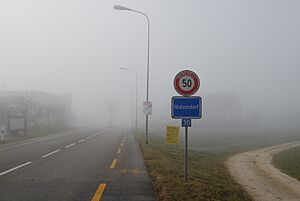Matzendorf facts for kids
Quick facts for kids
Matzendorf
|
||
|---|---|---|

Landgasthof Sonne in Matzendorf village
|
||
|
||
| Country | Switzerland | |
| Canton | Solothurn | |
| District | Thal | |
| Area | ||
| • Total | 11.27 km2 (4.35 sq mi) | |
| Elevation | 510 m (1,670 ft) | |
| Population
(Dec 2020 )
|
||
| • Total | 1,321 | |
| • Density | 117.21/km2 (303.58/sq mi) | |
| Postal code |
4713
|
|
| Surrounded by | Aedermannsdorf, Laupersdorf, Mümliswil-Ramiswil, Rumisberg (BE), Wolfisberg (BE) | |
Matzendorf is a small town, also called a municipality, located in the beautiful Thal district of Switzerland. It is part of the canton of Solothurn. Matzendorf is a friendly place where people live and work, surrounded by nature.
Contents
Matzendorf's Early History
Matzendorf has a long history! It was first mentioned in old writings way back in the year 968. At that time, its name was spelled Mazendorf. Later, in 1227, it was called apud Macindorf. These old names help us learn about the town's past.
Exploring Matzendorf's Geography
Matzendorf covers an area of about 11.25 square kilometers (about 4.34 square miles). Imagine a space about half the size of a big city airport! A large part of this area, about 40.7%, is used for farming. This means there are many fields and farms around the town.
Even more of the land, about 51.6%, is covered by forests. These are thick woods, perfect for exploring or just enjoying nature. The rest of the land is where buildings and roads are, making up about 7.8% of the area. There are also small rivers or lakes, covering about 0.2%.
Matzendorf is nestled in the Thal district, right in the Dünnern valley. The main part of the town is a haufendorf village. This means it grew without a strict plan, so its streets and buildings are a bit irregular and close together, often around a central area. There is also a smaller area called Mühli, which is a tiny hamlet.
Matzendorf's Coat of Arms
Every town has a special symbol called a coat of arms. Matzendorf's coat of arms is described as Per pale Argent two Angle Plates in Saltire counterchanged. This means it has a shield divided into two halves. On each half, there are two L-shaped figures that look like they are crossing each other. The colors of these shapes are swapped on each side of the shield.
Understanding Matzendorf's Population
Matzendorf has a population of about 1,300 people. A small number of these residents, about 4.8%, are people from other countries. Over the last ten years, the number of people living in Matzendorf has stayed pretty much the same.
Most people in Matzendorf speak German, which is the main language in the area. A smaller number of people speak Albanian or Serbo-Croatian.
In Matzendorf, there are slightly more men than women. Most people living here were born either in Matzendorf itself or somewhere else in the same canton. About 5.7% of the residents were born outside of Switzerland.
The town has a good mix of ages. About 8% of the population are young children (0-6 years old), and about 22.4% are teenagers (7-19 years old). Adults make up the largest part of the population, with many people between 25 and 64 years old. There are also many older adults, with about 13.6% of the population being 65 or older.
Most people in Matzendorf live in private homes. The average household has about 2.8 people. Many homes are single-family houses, meaning one family lives in one building. There are also some buildings with multiple apartments.
The historical population of Matzendorf has changed over time. You can see how the number of people living in Matzendorf has grown and changed through the years in the chart below.

Matzendorf's Economy and Jobs
Matzendorf has a healthy economy with many different types of jobs. Only a small number of people, about 2.1%, are looking for work.
Many people in Matzendorf work in the primary economic sector, which means jobs like farming. There are also jobs in the secondary sector, which includes manufacturing (making things) and construction (building things). The largest number of jobs are in the tertiary sector, which includes services. This means jobs in places like shops, restaurants, transportation, and healthcare.
About 633 people who live in Matzendorf have jobs. Many people who live in Matzendorf travel to other towns for work. However, some people also travel into Matzendorf for their jobs. Most people use a private car to get to work, while some use public transportation.
Religion in Matzendorf
In Matzendorf, most people are Roman Catholic, making up about 73.2% of the population. Another large group, about 17.2%, belong to the Swiss Reformed Church. There are also smaller numbers of people who belong to other Christian churches, like Orthodox or Christian Catholic.
Some people in Matzendorf follow the Islamic faith. A small number of people do not belong to any church; they might be agnostic (not sure if God exists) or atheist (do not believe in God).
Education in Matzendorf
Education is important in Matzendorf. Many adults have finished high school, and some have gone on to get higher education from a university or a specialized college.
The school system in Matzendorf, like in the rest of the Canton of Solothurn, offers two years of optional Kindergarten for young children. After kindergarten, students attend six years of primary school. After primary school, students go to secondary school. All students from Matzendorf who are in lower secondary school attend classes in a nearby town.
Many students from other towns come to Matzendorf to attend school, and some students from Matzendorf go to schools in other towns.
See also
 In Spanish: Matzendorf para niños
In Spanish: Matzendorf para niños











